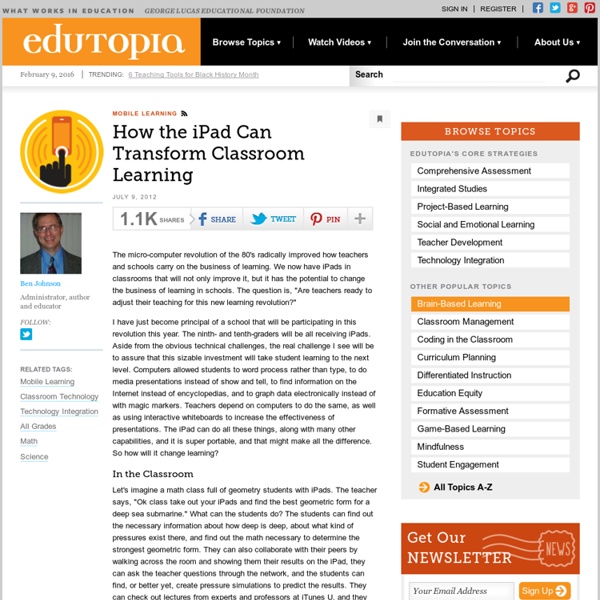How the iPad Can Transform Classroom Learning

cool Tools for 21st Century Learners: Digital Differentiation
Technology is a tool that can be used to help teachers facilitate learning experiences that address the diverse learning needs of all students and help them develop 21st Century Skills. At it's most basic level, digital tools can be used to help students find, understand and use information. When combined with student-driven learning experiences fueled by Essential Questions offering flexible learning paths, it can be the ticket to success. Here is a closer look at three components of effectively using technology as a tool for digital differentiation. Note: The interactive graphics you see below have been updated. The goal is to design student-driven learning experiences that are fueled by standards-based Essential Questions and facilitated by digital tools to provide students with flexible learning paths. Essential Questions: Student-driven learning experiences should be driven by standards-based Essential Questions. Teacher Facilitated Learning Experiences:
Using Blogs in a History Classroom
What Is It? Using the technology of blogging in the classroom to improve critical thinking and analysis skills. Rationale Using a teacher-created blog in a history classroom is a way to engage students through a different medium. Students of today relate more and more to technology and will welcome a different way of learning. Using a teacher-created blog will also allow you and your students to exchange ideas in an asynchronous environment. Description This teaching guide will assist teachers who want to set up their own blogs for their history classrooms. Teacher Preparation Choose a site. The screenshot above shows what appears after a student clicks on the comment link. In the Classroom There are several different ways a teacher-created blog can be used in a history classroom. Have students post ideas and opinions about topics discussed in class.Have students post potential thesis statements and allow other students to comment on each thesis. Common Pitfalls Acknowledgments Bibliography
Making of America
aking of America (MoA) is a digital library of primary sources in American social history from the antebellum period through reconstruction. The collection is particularly strong in the subject areas of education, psychology, American history, sociology, religion, and science and technology. The collection currently contains approximately 10,000 books and 50,000 journal articles with 19th century imprints. For more details about the project, see About MoA. Making of America is made possible by a grant from the Andrew W. New Additions: We have recently added a new feature, subject browsing. 99 more volumes focusing on New York City were added to MoA in June 2007.
splcenter
Three years after a first-of-its-kind study found that more than half of the states fail at teaching the civil rights movement to students, a new report released today by the SPLC’s Teaching Tolerance project shows that coverage of the movement in U.S. classrooms remains woefully inadequate. The study – Teaching the Movement 2014: The State of Civil Rights Education in the United States – examines standards and curriculum resources related to the study of the modern civil rights movement for all 50 states and the District of Columbia. This update to the 2011 Teaching the Movement study compares the requirements in state standards to a body of knowledge that reflects what civil rights historians and educators consider core information about the civil rights movement. The 2014 study was also expanded to include a review of the resources and materials that states offer to teachers. In this new report, 20 states received grades of “F.” “Want to have a meaningful ‘conversation about race?’”
Flipping Your History Classroom: Educational Technology to Bring the Past Alive | US History Scene
So you want to flip your history classroom and integrate digital learning but you have no idea where to start? We’ve got you covered. Below is a list of resources (both free and for a fee) along with project ideas that can help facilitate new modes of learning in your history class. 1. 2. 3. 4. Zeega ( a great free alternative for lower income schools that cannot rely on camera/video editing equipment)If your school or city has access, iMovie and Final Cut Pro are also useful tools 5. 6. InstagramFacebook photo albums (create a class project page)American Memory from the Library of Congress 7. 8. 9. 10. 3D and Museum Objects: If you want students to interact with a rare object or book that would be too fragile to leave the archive, consider asking a librarian or curator to help you make a 3D digital model for your classroom. 11. 12. Markup 13. Rhae Lynn Barnes is a Presidential Instructional Technology Fellow and doctoral candidate in the Department of History at Harvard University.
FacebookAvi
Related:
Related:



